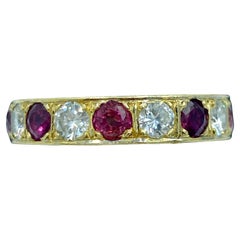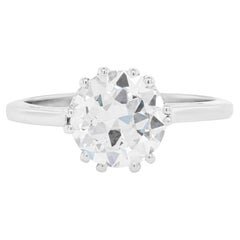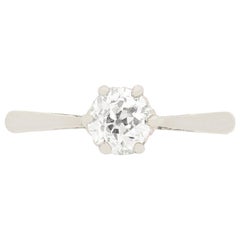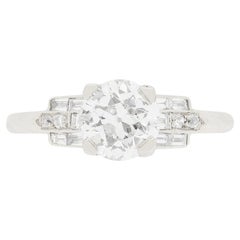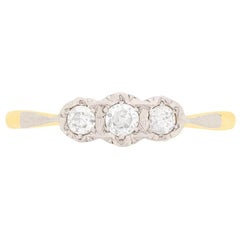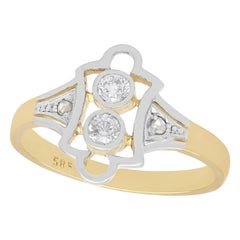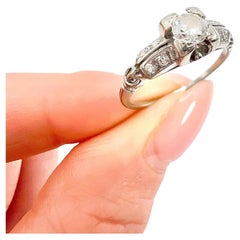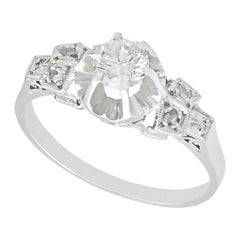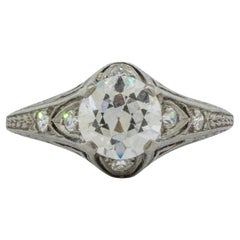Antique 1920S Engagement Rings
1920s British Art Deco Antique 1920S Engagement Rings
Diamond, Ruby, 18k Gold
1920s English Art Deco Antique 1920S Engagement Rings
Diamond, Platinum
1920s Unknown Antique 1920S Engagement Rings
Diamond, 18k Gold, Platinum
1920s Unknown Art Deco Antique 1920S Engagement Rings
Diamond, Platinum
1920s Unknown Antique 1920S Engagement Rings
Diamond, 18k Gold, Platinum
Early 20th Century Unknown Antique 1920S Engagement Rings
Diamond, 14k Gold, White Gold, Yellow Gold
Early 20th Century European Antique 1920S Engagement Rings
Diamond, 18k Gold, White Gold
1920s Antique 1920S Engagement Rings
Diamond, Platinum
1920s American Art Deco Antique 1920S Engagement Rings
Diamond, Platinum
1920s English Edwardian Antique 1920S Engagement Rings
Diamond, Platinum
1920s Art Deco Antique 1920S Engagement Rings
Diamond, Platinum
Early 20th Century Art Deco Antique 1920S Engagement Rings
Diamond, Platinum
Early 20th Century Art Deco Antique 1920S Engagement Rings
Diamond, Platinum
1920s Art Deco Antique 1920S Engagement Rings
Diamond, Platinum
1920s Art Deco Antique 1920S Engagement Rings
Diamond
1920s Unknown Art Deco Antique 1920S Engagement Rings
Diamond, Platinum
1920s English Edwardian Antique 1920S Engagement Rings
Diamond, Platinum
1920s Art Deco Antique 1920S Engagement Rings
Sapphire, Diamond, 18k Gold, White Gold
1920s Art Deco Antique 1920S Engagement Rings
Diamond, Platinum
1920s French Art Deco Antique 1920S Engagement Rings
Diamond, White Diamond, Platinum
Early 20th Century Edwardian Antique 1920S Engagement Rings
Diamond, Platinum
1920s Unknown Art Deco Antique 1920S Engagement Rings
Diamond, 18k Gold, Platinum
1920s Art Deco Antique 1920S Engagement Rings
Diamond, Platinum
1920s Antique 1920S Engagement Rings
Diamond, Platinum
1920s Unknown Art Deco Antique 1920S Engagement Rings
Diamond, 18k Gold, White Gold
1920s Unknown Art Deco Antique 1920S Engagement Rings
Diamond, Platinum
1920s Unknown Art Deco Antique 1920S Engagement Rings
Diamond, 18k Gold, Platinum
1920s American Art Deco Antique 1920S Engagement Rings
Diamond, Gold, 14k Gold, White Gold
1920s Unknown Art Deco Antique 1920S Engagement Rings
Diamond, 14k Gold, Gold, Yellow Gold
1920s Unknown Art Deco Antique 1920S Engagement Rings
Diamond, Platinum
1920s Unknown Art Deco Antique 1920S Engagement Rings
Diamond, Platinum
1920s European Art Deco Antique 1920S Engagement Rings
Diamond, Platinum
1920s American Art Deco Antique 1920S Engagement Rings
Diamond, Platinum
1920s Unknown Art Deco Antique 1920S Engagement Rings
Diamond, 18k Gold, Platinum
1920s Unknown Art Deco Antique 1920S Engagement Rings
Diamond, Platinum
Early 20th Century Antique 1920S Engagement Rings
Diamond, 18k Gold, Yellow Gold
1920s Unknown Art Deco Antique 1920S Engagement Rings
Diamond, 18k Gold
1920s American Art Deco Antique 1920S Engagement Rings
Diamond, Platinum
Early 20th Century English Antique 1920S Engagement Rings
Diamond, Onyx, 18k Gold, Yellow Gold
1920s Antique 1920S Engagement Rings
Diamond, Gold, 18k Gold, White Gold, Platinum
1920s Edwardian Antique 1920S Engagement Rings
Diamond, Emerald, Platinum
1920s English Edwardian Antique 1920S Engagement Rings
Diamond, Platinum
Early 20th Century Unknown Art Deco Antique 1920S Engagement Rings
Diamond, Platinum
Early 20th Century European Antique 1920S Engagement Rings
Diamond, Gold, 18k Gold, Platinum
1920s English Art Deco Antique 1920S Engagement Rings
Diamond, Platinum
1920s English Art Deco Antique 1920S Engagement Rings
Diamond, Platinum
1920s Antique 1920S Engagement Rings
Platinum
1920s Unknown Art Deco Antique 1920S Engagement Rings
White Diamond, Emerald, Platinum
1920s Unknown Antique 1920S Engagement Rings
Diamond, Platinum
Early 20th Century European Antique 1920S Engagement Rings
Diamond, Platinum
Early 20th Century French Antique 1920S Engagement Rings
Diamond, 18k Gold, White Gold
Early 20th Century English Antique 1920S Engagement Rings
Diamond, Sapphire, 18k Gold, White Gold
1920s Unknown Art Deco Antique 1920S Engagement Rings
Diamond, 18k Gold, Platinum
Early 20th Century European Art Deco Antique 1920S Engagement Rings
Diamond, Onyx, Gold, 18k Gold
1920s Unknown Art Deco Antique 1920S Engagement Rings
Diamond, 18k Gold, Platinum
1920s Antique 1920S Engagement Rings
Diamond, Platinum
1920s French Antique 1920S Engagement Rings
Diamond, Platinum
1920s Unknown Antique 1920S Engagement Rings
Diamond, 14k Gold, Yellow Gold
1920s Art Deco Antique 1920S Engagement Rings
Diamond, Sapphire, Platinum
1920s Antique 1920S Engagement Rings
Diamond, Platinum
- 1
- ...
Antique 1920S Engagement Rings For Sale on 1stDibs
How Much are Antique 1920S Engagement Rings?
A Close Look at Art-deco Jewelry
Fascination with the Jazz Age is endless, and even today jewelry designers continue to be inspired by authentic Art Deco jewelry and watches.
The Art Deco period, encompassing the 1920s and ’30s, ushered in a very distinct look in the design of jewelry. There were many influences on the jewelry of the era that actually began to take shape prior to the 1920s. In 1909, Serge Diaghilev brought the Ballet Russes to Paris, and women went wild for the company’s exotic and vibrant costumes It’s no wonder, then, that jade, lapis lazuli, coral, turquoise and other bright gemstones became all the rage. There already existed a fascination with the East, particularly China and Japan, and motifs consisting of fans and masks started to show up in Art Deco jewelry.
However, the event that had the greatest influence on Deco was the excavation of the tomb of King Tut in 1922. When the world saw what was hidden in Tut’s burial chamber, it sent just about everyone into a frenzy. Pierre Cartier wrote in 1923 that “the discovery of the tomb will bring some sweeping changes in fashion jewelry.” And he couldn’t have been more right. “Egyptomania” left an indelible mark on all of the major jewelry houses, from Cartier to Van Cleef & Arpels, Boucheron and Georges Fouquet. (Cartier created some of the most iconic jewelry designs that defined this era.)
While a lot of Art Deco jewelry was black and white — the black coming from the use of onyx or black enamel and the white from rock crystal and diamonds — there is plenty of color in jewelry of the era. A perfect accent to diamonds in platinum settings were blue sapphires, emeralds and rubies, and these stones were also used in combination with each other.
Many designers employed coral, jade and lapis lazuli, too. In fact, some of the most important avant-garde jewelers of the period, like Jean Després and Jean Fouquet (son of Georges), would combine white gold with ebony and malachite for a jolt of color.
A lot of the jewelry produced during this time nodded to current fashion trends, and women often accessorized their accessories. The cloche hat was often accented with geometric diamond brooches or double-clip brooches. Backless evening dresses looked fabulous with sautoir necklaces, and long pearl necklaces that ended with tassels, popular during the Edwardian period, were favored by women everywhere, including Coco Chanel.
Find unique Art Deco necklaces, earrings, bracelets and other jewelry on 1stDibs.
The Legacy of Diamond in Jewelry Design
Antique diamond rings, diamond tiaras and dazzling vintage diamond earrings are on the wish lists of every lover of fine jewelry. And diamonds and diamond jewelry are primarily associated with storybook engagements and red-carpet grand entrances — indeed, this ultra-cherished gemstone has a dramatic history on its hands.
From “A Diamond Is Forever” to “Diamonds Are a Girl’s Best Friend,” pop culture has ingrained in our minds that diamonds are the most desired, the most lasting and the most valuable gemstone. But what makes the diamond so special? Each stone — whether it’s rubies, sapphires or another stone — is unique and important in its own right. April babies might claim diamonds for themselves, but just about everyone wants this kind of sparkle in their lives!
There are several factors that set diamonds apart from other stones, and these points are important to our gem education.
Diamonds are minerals. They are made up of almost entirely of carbon (carbon comprises 99.95 percent; the remainder consists of various trace elements). Diamonds are the hardest gemstones, ranking number 10 on the Mohs Hardness Scale. Even its name, diamond, is rooted in the Greek adamas, or unconquerable. The only object that can scratch a diamond is another diamond. Diamonds are formed deep within the earth at very high temperatures (1,652–2,372 degrees Fahrenheit at depths between 90 and 120 miles beneath the earth’s surface) and are carried up by volcanic activity. Diamonds are quite rare, according to the Gemological Institute of America, and only 30 percent of all the diamonds mined in the world are gem quality.
In the 1950s, the Gemological Institute of America developed the 4Cs grading system to classify diamonds: clarity, color, cut and carat weight. Not all diamonds are created equal (there are diamonds, and then there are diamonds). The value of the diamond depends on the clarity (flawless diamonds are very rare but a diamond's value decreases if there are many blemishes or inclusions), color (the less color the higher the grade), cut (how the diamond’s facets catch the light, certain cuts of diamonds show off the stone better than others) and carat weight (the bigger, the better).
When you start shopping for a diamond engagement ring, always prioritize the cut, which plays the largest role in the diamond's beauty (taking the time to clean your diamond ring at least every six months or so plays a role in maintaining said beauty). And on 1stDibs, a range of buying guides can be found for those in the market for antique engagement rings, vintage engagement rings or Art Deco engagement rings.
Shop antique and vintage diamond rings, diamond necklaces and other extraordinary diamond jewelry on 1stDibs.
Finding the Right Rings for You
Antique and vintage rings have long held a special place in the hearts of fine jewelry lovers all over the world.
No matter their origin or specific characteristics, rings are timeless, versatile accessories. They’ve carried deep meaning since at least the Middle Ages, when diamond rings symbolized strength and other kinds of rings were worn to signify romantic feelings or to denote an affiliation with a religious order. Rings have also forever been emblematic of eternity.
Over time, rings have frequently taken the form of serpents, which have long been associated with eternal life, health and renewal. Italian luxury jewelry house Bulgari has become famous for its widely loved Serpenti motif, for example, and its Serpenti ring, like the other accessories in the collection, began as an homage to jewelry of the Roman and Hellenistic eras. The serpent is now a popular motif in fine jewelry. Jewelry devotees have long pined for rings adorned with reptiles, thanks to antique Victorian rings — well, specifically, Queen Victoria’s illustrious engagement ring, which took the form of a gold snake set with rubies, diamonds and an emerald (her birthstone). Designs for Victorian-era engagement rings often featured repoussé work and chasing, in which patterns are hammered into the metal.
Engagement rings, which are reliably intimidating to shop for, are still widely recognized as symbols of love and commitment. On 1stDibs, a range of buying guides can be found for those in the market for antique engagement rings, vintage engagement rings or Art Deco engagement rings.
The most collectible antique engagement rings and vintage engagement rings are those from the Victorian, Edwardian and Art Deco eras. Named for the monarchies of the four King Georges, who in succession ruled England starting in 1714 (plus King William’s reign), antique Georgian rings, be they engagement rings or otherwise, are also coveted by collectors. Pearls, along with colored gemstones like garnets, rubies and sapphires, were widely used in Georgian jewelry. The late-1700s paste jewelry was a predecessor to what we now call fashion or costume jewelry.
The Art Nouveau movement (1880–1910) brought with it rings inspired by the natural world. Antique Art Nouveau rings might feature depictions of winged insects and fauna as well as women, who were simultaneously eroticized and romanticized, frequently with long flowing hair. Art Deco jewelry, on the other hand, which originated during the 1920s and ’30s, is by and large “white jewelry.” White metals, primarily platinum, were favored over yellow gold in the design of antique Art Deco rings and other accessories as well as geometric motifs, with women drawn to the era’s dazzling cocktail rings in particular.
Whether you’re hunting down a chunky classic for a Prohibition-themed cocktail party or seeking a clean contemporary design to complement your casual ensemble, find an exquisite collection of antique, new and vintage rings on 1stDibs.
- 1stDibs ExpertNovember 21, 2023In the 1920s, engagement rings still looked like rings but were representative of a diverse range of styles and influences. Art Deco diamond ring designs took inspiration from the contemporary Cubist movement as well as from ancient Egypt – a revival sparked by the opening of King Tut’s tomb in 1922. Native American, African and Asian motifs also inspired jewelry pieces. Diamonds in square and rectangular shapes incorporating angular steps – like emerald cuts, Asscher cuts and baguettes – were set against black onyx, rubies, sapphires and emeralds to create color-blocking effects. Platinum, 18-karat gold, 14-karat white gold and sterling silver were some of the favored metals of the decade. Find a wide range of Art Deco engagement rings on 1stDibs.
- 1stDibs ExpertNovember 21, 2023Yes, antique engagement rings do tend to be popular. They especially appeal to brides-to-be who want something unique and like the idea of owning a ring that has a long history. Rings from the Victorian, Edwardian and Art Deco eras are among the most highly sought-after antique options. On 1stDibs, explore a wide variety of antique engagement rings.
- 1stDibs ExpertNovember 1, 2023The difference between vintage and antique engagement rings is age. For an engagement ring to be considered an antique, it must be at least 100 years old. Vintage engagement rings are pieces made at least 20 years ago. Shop a collection of vintage and antique engagement rings on 1stDibs.
- 1stDibs ExpertJanuary 23, 2024The difference between vintage, antique and estate engagement rings comes down to age and history. Rings that are over 100 years old are antiques, while those produced 20 to 99 years ago are vintage. Estate engagement rings are any rings that have had a previous owner. They can include antique, vintage and even contemporary rings produced during the last 20 years. Shop a large selection of engagement rings on 1stDibs.
- 1stDibs ExpertNovember 21, 2023In the early 1900s, engagement rings often looked like other jewelry from the Edwardian era, which coincided with the reign of King Edward VII in the United Kingdom from 1901 to 1910. Cutters used new diamond saws and jewelry lathes to refine the old European cut. The resulting stones, designed to sparkle in the light from candles and gas lamps, are beloved by connoisseurs for their inner fire and romantic glow. The invention of the oxyacetylene torch enabled jewelers to use platinum, which had previously been too challenging to work with. This technological advancement made it possible for Edwardian rings to show off lacy filigree and milgrain work. Nature also influenced jewelry in the early 1900s. Flowing and floral garland motifs were so popular that the Edwardian age is sometimes called the "garland era." Find a selection of Edwardian engagement rings on 1stDibs.
Read More
Our Guide to Victorian, Edwardian and Art Deco Engagement Rings
Learn about these antique jewelry styles, then choose a design that speaks to you.
Experts Talk Engagement Ring Trends and Shopping Tips
Ready to rock? Some of our favorite jewelry designers and dealers share indispensable advice for choosing that most important ring.
How to Buy a Vintage or Antique Engagement Ring
Will your beloved be enchanted by an Edwardian ring or a trendy Art Deco piece? We clue you into period styles and tips for finding the perfect ring.
